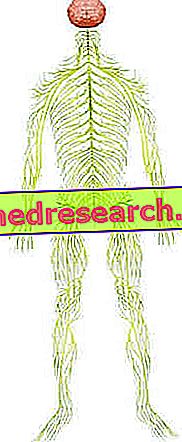Generality
Peripheral neuropathy is the morbid condition resulting from deterioration and malfunction of peripheral nerves.
The causes of peripheral neuropathy are numerous; diabetes is the main trigger, at least for industrialized countries like Italy or the United Kingdom.

To plan an adequate therapy, a very careful diagnostic investigation is necessary: the identification of the causes and the subsequent treatment are of fundamental importance.
Brief reference to the nervous system
The nervous system is a collection of organs, tissues and nerve cells (neurons), capable of receiving, analyzing and processing stimuli coming from inside and outside the body.
At the end of the elaboration, the nervous system generates appropriate responses to the situation, which favor the survival of the organism to which it belongs.
The nervous system of vertebrates consists of two components:
- The central nervous system ( CNS ): is the most important part of the nervous system, a veritable data processing and control center. In fact, it analyzes the information coming from the external and internal environment of the organism, therefore it formulates the most appropriate answers to the aforementioned information.
It is composed of brain and spinal cord.
- The peripheral nervous system ( PNS ): is the "arm" of the central nervous system. In fact, his job consists in transmitting to the CNS all the informative data captured inside and outside the organism and in spreading all processing with origin in the CNS towards the periphery.
Without the SNP, the central nervous system could not function properly.
What is peripheral neuropathy?
Peripheral neuropathy is the morbid condition resulting from damage and malfunction of the nerves of the peripheral nervous system (PNS).
PERIPHERAL NERVOUS SYSTEM
In addition to the above, the peripheral nervous system effectively helps the central nervous system, as it has a large network of nerves .
The nerves are a set of axons, or extensions of neurons that spread the nervous signal.
Thanks to its nerves, the SNP communicates with the arms, hands, feet, legs and internal organs (this was referred to first with "the information data collected inside the body"), the mouth and the face.
The cranial nerves and spinal nerves, which originate respectively in the brain and spinal cord, are part of the SNP.
These nerves are of the type:
- Sensitive . A sensory nerve is a nerve that carries sensory information, picked up in the periphery. Pain, tactile perception and proprioceptive sensitivity are just some examples of sensory information.
- Motor . Motor nerves are the nerves that control skeletal muscles. To put them into action is a signal that originates in the central nervous system.
- Autonomous . Autonomous nerves are the nerves that regulate the automatic functions of the body, such as blood pressure, digestion or the bladder filling / emptying process.
Causes
Peripheral neuropathy has numerous causes.
Among these, diabetes mellitus deserves a special mention, since, in the so-called countries of the Western world (therefore also in Italy), it is very probably one of the main triggers.
DIABETES
Diabetes mellitus is a metabolic disease caused by a defect in the secretion and / or action of insulin, a hormone essential for the passage of glucose from the blood to the cells.
Following failure of insulin secretion and / or malfunction, blood glucose levels ( blood glucose ) increase and a very dangerous condition for the body, known as hyperglycemia, is established .
Peripheral neuropathy that occurs due to diabetes mellitus is also called diabetic neuropathy .
According to the most recent and reliable theories, hyperglycemia would be the cause of diabetic neuropathy. In fact, the high levels of glucose in the blood would damage the blood vessels supplying peripheral nerves (ie the nerves of the peripheral nervous system ) with oxygen and nutrients.
Without oxygen and nutrients, any nerve, tissue or organ in the body undergoes a process of death, more properly referred to as necrosis .
Various conditions contribute to increasing the risk of peripheral neuropathy in a person with diabetes mellitus, including:
- hypertension
- Overweight and obesity
- Be over 40 years old
- Consume large quantities of alcoholic beverages
- To smoke
OTHER CAUSES OF PERIPHERAL NEUROPATHY
A form of peripheral neuropathy can also arise due to or following:
- State of serious alcoholism . Alcoholics do not adequately absorb ingested foods and are often subject to episodes of diarrhea and vomiting. This results in a state of malnutrition, in some cases even very severe, which particularly affects vitamins.
Vitamins (in particular B12, B1, B6, niacin and E) are fundamental for the good health of the nervous system, therefore their deficiency entails, among the various consequences, also the deterioration of the nerves of the peripheral nervous system .
- Vitamin deficiencies due to causes other than alcoholism . If certain foods are, by choice (incorrect) or lack of availability, excluded from the diet, it is likely that certain vitamins are not taken in adequate quantities. This can have a negative impact on the nervous structures, just as in the case of alcoholism.
- Chronic kidney diseases . If the kidneys are malfunctioning, there is an accumulation of toxic substances in the body; toxic substances that damage the nervous system, including peripheral nerves.
- Chronic liver disease . Similar to the kidneys, if the liver works badly, the blood accumulates toxic waste products and infectious agents; the latter, in the long run, cause damage to nerve cells, including those that make up the peripheral nerves.
- Inflammation of blood vessels ( vasculitis ).
- State of hypothyroidism . Hypothyroidism is a morbid condition that is established due to an underactive thyroid. An underactive thyroid produces insufficient amount of thyroid hormones for the body's needs.
- Infections such as Lyme disease, diphtheria, botulism, shingles and AIDS . These morbid states arise due to viruses or bacteria, capable of invading and damaging nerve cells.
- Autoimmune diseases, including Guillain-Barré syndrome, rheumatoid arthritis, systemic lupus erythematosus, Sjögren's syndrome and chronic inflammatory demyelinating polyneuropathy . Those who suffer from an autoimmune disease have an immune system that acts improperly. In fact, it attacks healthy tissues and organs through its cells.
- Amyloidosis . It is the medical term for identifying a group of diseases characterized by the accumulation, often in the extracellular area, of the so-called amyloid fibrils. Insoluble, amyloid fibrils compromise the functionality of various tissues and organs of the body, including the nervous structures.
- Charcot-Marie-Tooth disease and the like . Charcot-Marie-Tooth disease, also known as hereditary motor-sensory neuropathy, is an inherited neurological syndrome affecting the peripheral nervous system. Therefore, its onset causes a deterioration of the peripheral nerves, in particular those destined to the lower limbs.
- A physical trauma that damages peripheral nerves . The classic physical traumas that can cause damage to peripheral nerves are those following road accidents, falls (for example from a horse) or bone fractures.
- Nerve compression syndromes . They are pathologies due to the crushing (or compression) of a nerve, by the surrounding tissues or by the presence of a tumor mass. Thus the compressed nerve becomes irritated, causes pain and loses its functions.
A classic example of peripheral neuropathy due to compression of a peripheral nerve is carpal tunnel syndrome.
- Tumors, such as lymphoma and multiple myeloma . A lymphoma is a malignant tumor of the glandular apparatus that constitutes the lymphatic system (lymph nodes).
Multiple myeloma is a malignant tumor that affects certain cells of the immune system. The latter, in fact, begins to produce an abnormal protein that causes kidney problems and damages other organs and tissues in the body.
- Exposure to toxic substances, such as insecticides, arsenic, lead, mercury and heavy metals in general.
- Monoclonal gammopathies of uncertain significance . They are pathologies characterized by huge presence, in the blood, of an abnormal protein of lymphoid origin. Producing this protein are plasma cells, which are the cells of the immune system that secrete antibodies.
- Connective tissue diseases . If they affect the connective tissue that surrounds the peripheral nerves, they can determine a form of peripheral neuropathy.
- Taking certain medications . Among the medicines incriminated, there are chemotherapy drugs for the treatment of cancer, blood pressure drugs, some antibiotics (metronidazole and nitrofurantoin) and anticonvulsants for the treatment of epilepsy (phenytoin).
Recently, it has been discovered that even statins for hypercholesterolemia favor the appearance of peripheral neuropathy.
Obviously, we are talking about long-term hiring.
Epidemiology
Peripheral neuropathy is a fairly common condition.
According to a British statistic, in the United Kingdom, it would affect one person out of every 50 of the general population and one individual out of every 10 of the population over 55.

Particularly interesting is the epidemiological aspect concerning the combination of peripheral diabetes-neuropathy. In fact, according to what the Center for Peripheral Neuropathy of the University of Chicago reports, about 60% of diabetics develop more or less serious damages in the peripheral nerves.
Symptoms and Complications
On a slow or rapid onset, the symptoms of peripheral neuropathy depend on the type of nerves involved: if sensory nerves are involved, there are sensory manifestations (sensory neuropathy ); if the motor nerves are involved, there are disorders in the skeletal muscles ( motor neuropathy ); finally, if the autonomic nerves are involved, one or more automatic functions are altered ( autonomous neuropathy ).
In reality, it is good to specify that, in most cases, we are witnessing the simultaneous involvement of different types of peripheral nerves. For example, peripheral neuropathies in which there is a simultaneous deterioration of the sensory and motor nerves ( sensory-motor polyneuropathies ) are very common.
The following are typical signs and symptoms of sensory neuropathy, motor neuropathy and autonomous neuropathy.
In the presence of a polyneuropathy, the clinical manifestations obviously overlap.
SENSIVE PERIPHERAL NEUROPATHY
The characteristic symptomatology of peripheral sensory neuropathy includes:
- Tingling and tingling in areas where damaged peripheral nerves reside.
- Sense of numbness and reduced ability to feel pain and temperature changes, especially in the hands and feet.
- Burning pain and similar to sharp pains, especially in the lower limbs and feet.
- Allodynia, or pain caused by a stimulus that, under normal conditions, would be completely harmless and without consequences.
- Loss of balance and coordination skills .
The pain felt during a peripheral neuropathy is a form of neuropathic pain. To be even more precise, it is called peripheral neuropathic pain .

MOTOR PERIPHERAL NEUROPATHY
The typical symptoms and signs of motor neuropathy are:
- Spasms and muscle cramps .
- Muscle weakness and / or paralysis affecting one or more muscles.
- Reduction of muscle mass due to inactivity.
- Falling foot . It is a particular condition characterized by the inability to hold up the front of the foot; this leads to considerable problems with walking.
- Frequent fall from the hands of objects .
AUTONOMOUS PERIPHERAL NEUROPATHY
The clinical manifestations that characterize autonomous neuropathy consist of:
- Constipation or diarrhea . The latter is frequent especially at night.
- Sense of malaise, abdominal bloating and vomiting .
- Decreased blood pressure ( orthostatic hypotension ), which induces a sense of fainting and / or vertigo.
- Tachycardia, or increase in heart rate.
- Excessive sweating or lack of sweating ( anhydrosis ).
- Sexual disorders . In humans, for example, erectile dysfunction is particularly frequent.
- Difficulty of complete emptying of the bladder .
- Intestinal incontinence due to loss of control of bowel smooth muscle.
- Dysphagia .
- Thinning of the skin .
mononeuropathy
Peripheral mononeuropathy means a peripheral neuropathy involving a single peripheral nerve . As a result, it is a condition that determines symptoms localized in a specific area.
A classic example of peripheral mononeuropathy is the aforementioned carpal tunnel syndrome, in which there is compression of the median nerve at the level of the wrist.
WHEN TO REFER TO THE DOCTOR?
In general, before a condition of peripheral neuropathy is identified and the greater the possibility of limiting the damage caused by it.
Therefore, if you are an individual at risk of peripheral neuropathy, it is good to pay close attention to symptoms and signs, such as:
- Tingling, numbness or loss of sensation in the hands and especially feet.
- Loss of balance.
- Cuts or wounds that do not heal, especially at the level of the feet.
- Intestinal problems, such as diarrhea or constipation, and bladder dysfunction.
- Fault in standing up.
COMPLICATIONS
The possible complications of peripheral neuropathy are numerous and depend, first of all, on the causes of deterioration of peripheral nerves.
For brevity, we point out the three main and probably most common complications, namely:
- Diabetic foot . It is one of the most feared consequences of diabetes. To learn more, we recommend that you consult the article here.
- The risk of gangrene . Gangrene is defined as the massive putrefaction of one or more body tissues. To cause such a process, it is the total lack of blood flow in that or those tissues affected. In the case of gangrene it is necessary to remove the necrotic tissue (ie undergoing necrosis). In the most serious cases, the amputation of a part of the body must also be used.
- Autonomous cardiovascular neuropathy . It is a morbid condition that completely disrupts different autonomous nerve functions, including blood pressure, heart rate, bladder control, sweating, etc.
Diagnosis
In general, doctors use different assessments and tests to diagnose peripheral neuropathy.
First of all, they carry out an accurate physical examination, during which the patient's symptoms and clinical history are investigated (NB: for clinical history, we mean the pathologies in progress, the diseases of the past, the drugs taken in that moment etc).

An accurate diagnostic procedure allows us to establish not the characteristics of peripheral neuropathy in place, but also the cause that triggered it .
Knowledge of the triggering factor allows the most appropriate therapy planning.
BLOOD ANALYSIS
Analyzes on a blood sample make it possible to determine whether the patient suffers from diabetes, some vitamin deficiency or thyroid dysfunction.
NEUROLOGICAL EVALUATION
During a neurological evaluation, the doctor analyzes the tendon reflexes and tests for the presence or absence of neuromuscular and coordinative disorders.
TAC AND NUCLEAR MAGNETIC RESONANCE (RMN)
CT and nuclear magnetic resonance (MRI) are very useful and provide discrete information when a tumor is suspected, a physical trauma to peripheral nerves or a compression syndrome.
ELECTROMYOGRAPHY
Electromyography involves the study of the conduction of nerve signals along the symptom manifesting area and, subsequently, the evaluation of the electrical activity of the muscle or muscles, always located in the symptomatic area.
For more information on electromyography, we recommend reading the article here.
BIOPSIA OF ONE OR MORE NERVES
A nerve biopsy consists of the collection and subsequent laboratory analysis of some nerve cells, which are considered responsible for the ongoing symptoms.
It can be useful to trace the causes of nerve damage.
CUTANEOUS BIOPSY
The analysis in the laboratory of skin cells, taken previously from an area of suffering skin, can be used to study the sensory nerves and to understand their state of health.
Treatment
When we talk about the treatment of peripheral neuropathy, we generally refer to treatments for improving the symptomatic picture ( symptomatic therapy ) and to treating the triggering causes .
In fact, it is necessary to specify a couple of aspects:
- In most cases, peripheral neuropathy is a condition from which it is impossible to heal.
The only therapeutic remedy, expected in these situations, is to try to alleviate the most serious symptoms, in the hope of giving relief to the patient.
- Regardless of whether peripheral neuropathy can be cured definitively or only improved from the point of view of symptoms, it is essential to act on the triggering causes.
For example, in the case of diabetes, the only way to delay or avoid the deterioration of peripheral nerve damage is to treat the disease with insulin or hypoglycemic administrations, keeping blood pressure under control, regulating body weight, etc.
Using another example, in the case of drug-induced peripheral neuropathies, the main therapeutic remedy (sometimes even the decisive one) is to stop taking the drug responsible for peripheral nerve deterioration.
- Currently, there is no cure or remedy to regenerate damaged neurons during peripheral neuropathy.
Other examples of treatments, which depend on the triggering causes:
- Immunosuppressants, immunoglobulins and corticosteroids, in the case of autoimmune diseases or inflammatory diseases.
- Vitamin supplements, for vitamin deficiencies.
- Surgery, for tumors that compress peripheral nerves or for nerve compression syndromes.
- Anti-cancer treatments (chemotherapy and radiotherapy), in the case of multiple myeloma or lymphoma.
NEUROPATHIC PAIN TREATMENT
Very often, neuropathic pain requires drugs with an anti-pain action other than those used in the presence of pain caused by trauma. Thus, paracetamol or ibuprofen are usually ineffective.
The medicines used for neuropathic pain include:
- Antiepileptics, such as gabapentin and pregabalin. As side effects, they show drowsiness and dizziness.
- Antidepressants, such as amitriptyline, doxepin, nortriptyline, duloxetine (a serotonin and norepinephrine reuptake inhibitor) and venlafaxine.
Some undesirable effects of these drugs are dry mouth, nausea, drowsiness, dizziness, constipation and / or decreased appetite.
- Opioid-type painkillers, such as tramadol. It is a derivative of morphine, so its long administration is highly dangerous because it can be addictive.
Side effects include: feeling sick, vomiting, dizziness and / or constipation.
- Capsaicin in cream . Capsaicin is a chemical compound found in hot pepper plants, which somehow manages to stop the painful signal sent from nerves to the brain. The preparation in cream should be spread 3 to 4 times a day on the area of the suffering body.
As side effects, it presents irritation and / or burning in the skin.

SYMPTOMATIC THERAPY
For patients with weakness or reduction in muscle mass, doctors advise physiotherapy, to keep the muscles strong.
Men suffering from erectile dysfunction prescribe appropriate treatments, taking into account the causes of the onset of peripheral neuropathy.
Those who suffer from hyperhidrosis plan botulinum toxin therapy.
To individuals with constipation, they recommend pharmacological preparations and a diet, to promote peristaltic movements .
Finally, for patients with bladder dysfunction, they indicate the use of bladder catheters .
Some important indications, related to the lifestyle that should be adopted in the presence of a peripheral neuropathy:
- Practicing physical exercise
- Not smoking
- Avoid alcohol consumption
- For diabetics, monitor your blood sugar regularly and take care of your feet
- Eat in a healthy and balanced way
Prevention
Forms of peripheral neuropathy due to modifiable risk factors (or causes), such as alcoholism or contact with heavy metals, can be largely prevented.
Unfortunately, the same cannot be said of forms of peripheral neuropathy due to genetic factors or diseases with unknown onset (autoimmune diseases).
Prognosis
As stated, many peripheral neuropathies are incurable; they can be treated only in the symptoms and in the progression, acting on the triggering causes.
In the presence of curable peripheral neuropathy, the prognosis depends on the timeliness of diagnosis and treatment.



